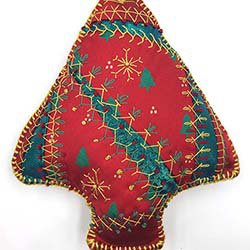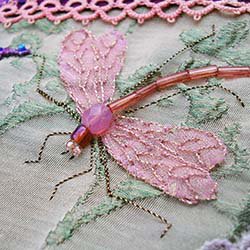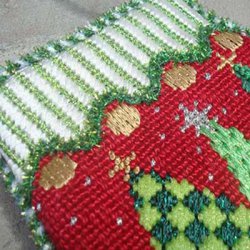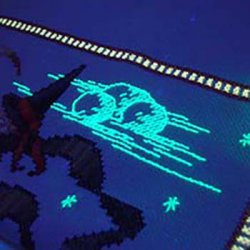-
Crazy Quilt Tree Ornament Pattern
NOTE: this is not a product that is shipped. Click the link below to download the PDF.
Crazy Quilt Tree Ornament
- Designed by Linda Lindgren
Linda has created a fun, quick-to-make holiday ornament. Use fabrics from a family member to make a special gift (Linda likes to use men's old ties). The Kreinik silk threads are perfect crazy quilt embellishments; the colors are rich, and the look is timeless. For crazy quilting, silk is nice and easy
Materials needed:
- Kreinik Silk Bella in 4164 Medium Victorian Green, 2014 Medium Gold, and 1117 Very Dark Christmas Red (one spool each)
- Kreinik Silk Serica in 2014 Medium Gold (one spool)
- 9-inch square firm interfacing and red velveteen
selection of red silks, satins, and Christmas prints, plus 1-inch wide green metallic ribbon - also: scissors, needles, matching sewing thread, polyester fiber fill
Instructions:
- Click here to download the FREE instructions for this design.You will need the Adobe Reader to view and print this file.
-
Santa's Pack Crazy Quilted Ornament
- Santa's Pack Crazy Quilt Ornament
- Designed by J Marsha Michler
- J. Marsha Michler has written extensive, informative and inspiring books on crazy quilting, so we asked her to design a special ornament for our web site visitors. You will be delighted at the effects of Kreinik metallic and silk threads for crazy quilting; for many projects, they're the only decorative threads you need to create beautiful work. The light-catching metallics and smooth, rich silk threads dance off the medley of fabrics and help you achieve exciting results. Use them in all kinds of stitches.
Materials needed:
For crazy patching:
- scissors, dry iron, spray bottle of water, pins, ironing board
- 1/2 yard of 100% cotton unbleached muslin fabric, pencil, ruler
- Silk fabric scraps such as jacquard, crepe de chine
- 1 1/2" x 10 1/2" piece of silk fabric for shoulder strap
- 100% cotton sewing thread, size 12 Sharp needle for basting
For embroidery:
- Embroidery hoop, scissors, needles in various sizes
- Kreinik Silk Serica in 8-10 shades of red, gold and green, such as: 3017, 1119, 1098, 4077, 1092, 4163, 4164, 2026, 2016
- Kreinik Heavy (#32) Braid or Medium (#16) Braid for couching in 202HL and 5982, or any shades of gold and green
- size 18 Chenille needle
- Kreinik Silk Bella in gold, green (such as 2016 and 4164)
For assembling the pack:
- 100% cotton sewing thread, any color that blends with the fabrics
- two 1" metal rings (the type used for cafe curtains)
- 24" soft 1/2" rayon ribbon, deep red
- small amount of poly stuffing
- miniature toys and other small objects
- sturdy wire (I used paper clips bent open), pliers
- white glue
- fine beading needle, white beading thread
- 18-inch length of Kreinik's Medium (#16) Braid, any shade of gold such as 202HL or 221
Instructions:
- Click here to download the FREE instructions for this design. You will need the Adobe Reader to view and print this file.
-
How to use metallics in crazy quilting
By Pat Winter, crazy quilt artist, designer and writer
I am a crazy quilter and I prefer Kreinik Metallic thread for my hand stitched seam treatments. Not only does Kreinik come in a variety of thicknesses, but the color assortment is amazing and fits all my designing needs. The ”vintage” colors are superb and among my favorite because I love to work in Victorian colors.
I first used Kreinik threads over 20 years ago when I combined it with my cotton floss in my cross stitch projects. The sparkle really made the piece come alive. I now use Kreinik metallic threads for my embroidery stitches in my crazy quilt items. Metallic threads make simple stitches stand out.
Is there a difference in thread?
I have tried various metallic threads as I would find them while browsing a quilt booth or new shop thinking they are all the same. I was surprised to find most of them frustrating to work with. They would break with very little pressure, and fray. I always use a sharp needle with a large eye when I hand sew with metallic threads so I was not adding stress by pulling thread through a tight fabric. I use every fabric imaginable in my crazy quilting and I can always depend on Kreinik threads to do the job with ease and no breakage.
Which thread for which design?
In most of my seams I prefer to use Very Fine # 4 braid and Fine #8 braid because it allows me to create small close stitches which I can add several combination stitches with by adding more colors to coordinate with the fabrics I used in the project. This makes a much more interesting seam in Fig. A.
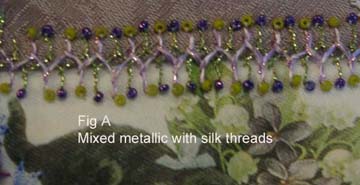
I use Blending Filament to outline a printed image or add it to a silk thread for a sparkle in fig. B.
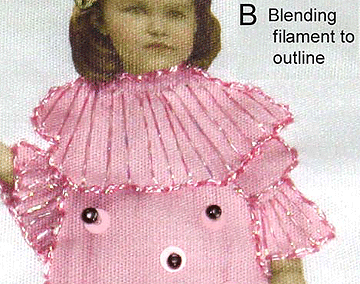
Cord is great for spider webs and legs of a beaded spider or insect. I also use it for the feather stitch down each dragonfly wing for great detail in fig. C.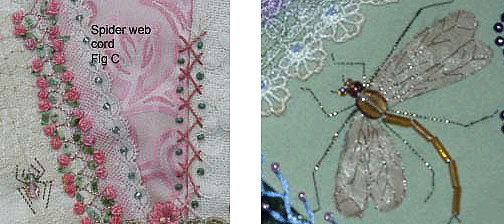
Larger seams call for larger threads. For these I use 1/16" Ribbon or Medium #16 Braid in fig. D.
Helpful hints when using metallic threads for hand stitching:
1. Always use a sharp needle with a large eye for smooth sewing and no tugging through fabrics.
2. Unwind a length of 18 inches and pull it through your fingers to unwind before you begin to sew. This relaxes it and it won't wind up on you.
3. I have never had Kreinik metallic thread tangle on me, but if you find this happening, run it through Thread Heaven, a light silicon lubricant or bees wax. -
How To Use Kreinik Micro Ice Chenille
Quick! Name five things that are fuzzy (bonus points for fuzzy metallic things). How about: garland on Christmas trees, legs on spiders, flower centers, bushy eyebrows, other, ahem, hairy things, peaches, caterpillars, lots of bugs actually, baby chicks, moldy cheese, your brain after a long weekend. How many could you list? Nature and life itself are full of texture. It makes things visually interesting and tactile.
You can recreate the fuzzy factor of true life objects with Kreinik's Micro Ice Chenille in your favorite hobby: needlepoint, cross stitch, embroidery, fly fishing, crochet, knitting, weaving. It adds whimsy, dimension, texture, and just plain visual interest to a design.What is Micro Ice Chenille and where can you use it?
- it's a fuzzy metallic
- couch in needlepoint, cross stitch, quilting, crazy quilting for surface embroidery (couch it with a Kreinik Cord or Very Fine #4 Braid, rather than stitch in and out)
- can also use it in long stitches in needlepoint if the canvas is not densely stitched (Micro Ice Chenille just doesn't like going in and out of fabric very much)
- combine it with any other fiber for cording and trims on stockings, ornaments, etc
- crochet little accessories and appliques (wreaths, flowers)
- use it in duplicate stitch in knitting (like a spider!)
To use in weaving:
- Can be used in weft, not for warp (too much stress)
- Weight/Yardage: Kreinik metallic yarns are not measured in terms of weight like wool or cotton yarns are, so measure by yard or meter. Purchase 50-meter cones; or cones of any amount by special order.
- Sett = 5 epi
- Care: Kreinik metallics don't felt, and are inelastic compared to some other types of yarns, so for best results, we recommend testing the threads with the weaving yarns you plan to use before beginning your project.
- Tips from weaver Deb Essen of DJE Handwovens: 1. Pull the thread off the cone horizontally, not from the top, to avoid adding twist to the fiber. 2. Combine with other yarns (rather than use a metallic exclusively) as an accent yarn for best results ("It makes a great, fun fabric"). 3. Test how the textures work together before making your main project: make test swatches if using stretchy yarns with the inelastic metallics, for instance, then use a warm-water wash for the wet-finishing. 4. You may want to experiment with looser sett to vary drapability. 5. Play! Have fun! "I love how the colors pop in sunlight or lamplight and shimmer as the piece is moved."
Content:
Cotton core, polyester metallic
-
Secrets of Blending Filament revealed!
Blending Filament is a one-of-a-kind thread that gives you a unique effect in your stitching. "There is nothing that can add more sparkle and pizzazz to your cross stitch than blending filament," says stitcher Bonnie Morrow. The hint of metallic adds light, interest and a 3-D effect. Is your project looking dull or flat? Blending Filament adds visual flavor without being over-the-top, just like a little spice adds flavor to your cooking.
One myth about Blending Filament is that it's difficult to use. While it may seem crazy to stitch with something akin to Christmas tree tinsel, the truth is that when you follow a few steps, it's not so hard. After all, a little time and effort IS worth the amazing results, whether you're starting a diet, crocheting an afghan, constructing a building, or adding sparkle to a stitched angel.
If you don't know how to use Blending Filament or if you get frustrated while using it, read on. Just a few tips will put the *sparkle * in your eyes.
5 Truths about Blending Filament
- It is actually two threads: the metallic part, and a thin string wound "within" the metallic that lends support. You may notice these two threads at the end of your Blending Filament, where they separate slightly. Any "frayed" ends can be hidden into your stitches as you start and stop, or clipped off once your starting point is secured. If the separation bothers you, use a product called Fray Check to seal the end.
- You CAN stitch with Blending Filament without the core string. Officially, we don't recommend it because it can make the filament prone to static and breaking. However, stitchers and designers tell us they occasionally remove the core from the flatter Hi Lustre colors and just take extra care to reduce static and breaking. So if the core REALLY bothers you, carefully separate it from the metallic and proceed with stitching.
- It is made of a different material than cotton floss. It may sound obvious, but sometimes we expect all thread types to behave the same way — and most of us hate to slow down. Blending Filament has a different consistency and thus requires more patience. You cannot stitch as quickly with it as you can cotton floss because of the slippery-ness of the metallic material. That's the nature of the unique filament. If it continuously slips off your needle while you're stitching, knot it to the needle.
- It's a delicate material, which is why some stitchers may find that it snaps or stretches. Blending Filament is a thin polyester material with slight elasticity. It is not as strong as silk. If your filament breaks or stretches while you are stitching, just adjust your tension (relax). This applies whether you are using Blending Filament for hand or machine embroidery.
- If you prefer, you can use Blending Filament by itself, rather than combined with cotton floss in one needle. Blending Filament was designed to be combined with another thread type; that is what produces the random metallic effect in a design. However, if you don't like stitching with two different threads at once, then don't. Simply stitch your area in one type first (like cotton floss), then overstitch with Blending Filament by itself. It may sound like double work, but actually this is the easiest way to control the filament, control how much highlight or shimmer you want in your design, and control exactly where you want it. This way, you're the one in control, not the thread.
10 Things you May Not Know About Blending Filament
- How do you get it started? The thread end is secured in a notch in the spool. Unwind the thread from the notch to start, and when you're done, secure the end in the notch again.
- How do you control it? Stitch slowly and use short lengths, which are easier to manage.
- Why did the designer call for it? It adds a SUBTLE metallic shimmer that makes a design more realistic or interesting. Use it in a design to replicate anything shiny in nature, or to add a HINT of whimsy, visual interest, and "bling."
- Is Balger the same as Blending Filament? "Balger" was the name Kreinik used when it started manufacturing threads in the 1970s. We've gone beyond Blending Filament with many thread types now, so we use distinct names, like Very Fine #4 Braid. Blending Filament refers to our thinnest, tinsel- or cord-like metallic threads.
- How many colors? Blending Filament comes in basic metallic, glow-in-the-dark, vintage, corded, and hi lustre colors. The hi lustre and vintage versions are flat for maximum light exposure. All together, we have over 100 Blending Filament colors available to you and designers.
- Blending Filament can be affected by humidity. Is your climate very dry? Then your filament may have more static in it as you stitch. Some stitchers recommend using a product called Thread Heaven, or a slightly damp cosmetic sponge, to "tame" flyaway filament.
- Don't try to use more than 2 strands of Blending Filament in one needle. There's just no need to. If you want a bolder metallic look, simply move up to a thicker thread, like Very Fine #4 Braid. Braid is used by itself rather than combined with another thread type in one needle.
- It's not just for cross stitch and needlepoint. Its thinness and blending qualities make it useful in tatting, crochet, knitting, crazy quilting, fly fishing, collage art, even stitching on paper.
- It's ideal for punchneedle. Use Blending Filament by itself in a 1-strand needle, or 1 strand of Blending Filament + 1 strand of cotton or silk floss in a 3-strand needle.
- Blending Filament is sold worldwide. From Australia to Alaska, South Africa to Saskatchewan and everywhere in between, Blending Filament is used by creative people everywhere. Kreinik has a US and international Store Locator listing on www.kreinik.com.


